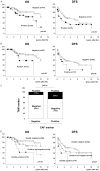The relationship between the tumor microenvironment of hepatocellular carcinoma - including cancer-associated fibroblasts and tumor-associated macrophages - and apparent diffusion coefficient
- PMID: 40371143
- PMCID: PMC12070086
- DOI: 10.62347/ZGGJ9531
The relationship between the tumor microenvironment of hepatocellular carcinoma - including cancer-associated fibroblasts and tumor-associated macrophages - and apparent diffusion coefficient
Abstract
The tumor microenvironment is critical for the acquisition of tumor malignancy in various cancer types. The objectives of this study were to investigate whether the levels of cancer-associated fibroblasts (CAFs) and tumor-associated macrophages (TAMs) reflect the prognosis of patients with hepatocellular carcinoma (HCC) after hepatectomy (Hx) and to determine whether the apparent diffusion coefficient (ADC) from diffusion-weighted imaging (DWI) reflects CAF and TAM expression. The study cohort comprised 109 patients who underwent initial curative resection for HCC. Alpha smooth muscle actin (αSMA) was selected as a CAF marker and CD204 as a TAM marker. Protein expression was immunohistochemically evaluated in the intratumoral regions of resected specimens. Clinicopathological factors, including the long-term prognosis after Hx, were investigated between αSMA-negative and -positive tumors and between CD204-negative and -positive tumors. The correlation between CAF/TAM marker expression and the calculated minimum ADC using DWI was also evaluated. αSMA-positive expression was correlated with tumor number, invasive growth pattern, and advanced stage. CD204-positive expression was correlated with the presence of venous invasion. Both αSMA-positive expression and CD204-positive expression were significant prognostic factors in the univariate analysis of overall survival and disease-free survival. αSMA/CD204 double positivity was associated with an extremely poor prognosis after Hx and was a significant independent prognostic factor for overall survival (P=0.02, hazard ratio: 3.27). Patients with double positivity also showed a significantly higher ADClow rate (83%). In conclusion, expression of both CAF and TAM markers reflected a poor prognosis after Hx. Furthermore, the preoperative ADC could be a clinical surrogate marker in the tumor microenvironment in patients with HCC.
Keywords: Tumor microenvironment; apparent diffusion coefficient; cancer-associated fibroblast; hepatocellular carcinoma; tumor-associated macrophage.
AJCR Copyright © 2025.
Conflict of interest statement
None.
Figures





Similar articles
-
The intratumoral distribution influences the prognostic impact of CD68- and CD204-positive macrophages in non-small cell lung cancer.Lung Cancer. 2018 Sep;123:127-135. doi: 10.1016/j.lungcan.2018.07.015. Epub 2018 Jul 19. Lung Cancer. 2018. PMID: 30089583
-
Prognostic significance of cancer-associated fibroblasts and tumor-associated macrophages in the tongue squamous cell carcinoma and their correlation with tumor budding.Oral Oncol. 2025 Jun;165:107295. doi: 10.1016/j.oraloncology.2025.107295. Epub 2025 May 5. Oral Oncol. 2025. PMID: 40327897
-
Collaboration of cancer-associated fibroblasts and tumour-associated macrophages for neuroblastoma development.J Pathol. 2016 Oct;240(2):211-23. doi: 10.1002/path.4769. Epub 2016 Sep 19. J Pathol. 2016. PMID: 27425378 Free PMC article.
-
Prognostic Value of Cancer-Associated Fibroblast Marker Expression in the Intratumoral and Marginal Areas of Soft Tissue Sarcoma.Pathobiology. 2025;92(1):1-17. doi: 10.1159/000539855. Epub 2024 Jul 22. Pathobiology. 2025. PMID: 38964294 Free PMC article.
-
Cancer-Associated Fibroblast Density, Prognostic Characteristics, and Recurrence in Head and Neck Squamous Cell Carcinoma: A Meta-Analysis.Front Oncol. 2020 Nov 27;10:565306. doi: 10.3389/fonc.2020.565306. eCollection 2020. Front Oncol. 2020. PMID: 33330034 Free PMC article.
References
-
- Rimassa L, Finn RS, Sangro B. Combination immunotherapy for hepatocellular carcinoma. J Hepatol. 2023;79:506–15. - PubMed
-
- Finn RS, Qin S, Ikeda M, Galle PR, Ducreux M, Kim TY, Kudo M, Breder V, Merle P, Kaseb AO, Li D, Verret W, Xu DZ, Hernandez S, Liu J, Huang C, Mulla S, Wang Y, Lim HY, Zhu AX, Cheng AL IMbrave150 Investigators. Atezolizumab plus bevacizumab in unresectable hepatocellular carcinoma. N Engl J Med. 2020;382:1894–905. - PubMed
-
- Abou-Alfa GK, Lau G, Kudo M, Chan SL, Kelley RK, Furuse J, Sukeepaisarnjaroen W, Kang YK, Van Dao T, De Toni EN, Rimassa L, Breder V, Vasilyev A, Heurgué A, Tam VC, Mody K, Thungappa SC, Ostapenko Y, Yau T, Azevedo S, Varela M, Cheng AL, Qin S, Galle PR, Ali S, Marcovitz M, Makowsky M, He P, Kurland JF, Negro A, Sangro B. Tremelimumab plus durvalumab in unresectable hepatocellular carcinoma. NEJM Evid. 2022;1:EVIDoa2100070. - PubMed
-
- Balkwill F, Mantovani A. Inflammation and cancer: back to Virchow? Lancet. 2001;357:539–45. - PubMed
-
- Medzhitov R. Origin and physiological roles of inflammation. Nature. 2008;454:428–35. - PubMed
LinkOut - more resources
Full Text Sources
